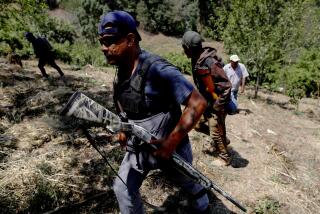WHY PROHIBITION WON’T WORK : Supply Only Follows Demand : The war on drugs shows the futility of suppressing a determined market--and handguns are as easy to produce as marijuana.
Local gun-control laws are notoriously ineffective. A city or state can hardly expect to ban weapons that are readily available in a nearby jurisdiction. Proponents of gun control say that this shows the need for federal curbs; only controls at the national level can be expected to stop the proliferation of black-market weapons.
This standard rationalization assumes that the national government would be able to suppress illegal markets in urgently demanded merchandise. Experience with liquor prohibition in the 1920s and more recently with the war on drugs should inspire more disbelief than confidence in that proposition.
Gun-control advocates want to see increasingly strict regulation of firearms in the legitimate market as well, including outlawing whole classes of weapons, such as handguns, “assault rifles” and automatic or semi-automatic weapons. The hope is that the increasingly scarce merchandise would eventually become unavailable even in the black market, except perhaps at prices so high that transactions would seldom occur.
This theory ignores the dynamics of markets. Rising prices signal sellers to supply fresh merchandise. The market, legal or illegal, will grow to meet demand unless another player--in this case, the government--can plug the pipeline to block fresh inventory. If interdiction were required, the war on guns would soon come to resemble the war on drugs.
The war on drugs costs the federal government about $10 billion a year. Most of the outlays go for interdiction--efforts to intercept supplies of drugs where they are grown, at the border or on the street. Yet, despite increasingly stringent enforcement, the prices for cocaine and marijuana have been stable for 20 years.
Thinking about our experience with cocaine should make us pessimistic about our prospects with firearms. Cocaine ought to be the easiest sort of contraband to control. We know where virtually all of the world’s coca bushes are grown: in the valley of the Huallaga River in Peru and in the uplands of four trans-Andean countries. Yet, despite our raiding and burning of crops; despite the billions spent on radar and satellite surveillance; despite the extraordinary harshness we have introduced into our criminal code with mandatory minimum sentences and death penalties for “kingpins”; despite our forfeiture laws that allow the government to seize smugglers’--and sometimes innocent parties’--boats and autos and other property without a trial; despite the fact that drug offenders now make up far more than half of federal criminal trial dockets and have dramatically increased in state systems as well--despite all of this, the retail price of cocaine remains steady.
The education that we have purchased with 20 years and perhaps $50 billion of drug interdiction efforts ought to make us smarter about guns. Black markets for guns could not possibly be less refractory than those for drugs. Peoples’ demand for guns is, if anything, more desperate than their demand for drugs. And there are fewer substitutes. Unlike cocaine, firearms don’t have to be imported; more like marijuana, they can be produced domestically and distributed by decentralized dealers. Producing first-rate weapons may be a high-skill operation that requires access to expensive machine tools (and thus is relatively easy to spot). But assembling functional guns from stamped prefabricated parts is no more difficult than cultivating marijuana.
Unlike cocaine, guns do not have only one place of origin. Unlike cocaine, which is made from coca paste, guns are assembled from mostly generic hardware that has other uses. Although assembled weapons are bulkier than drugs, disassembled weapons cannot be detected, as a shipment of marijuana can, by a police dog or a mass spectrometer. The importation of gun components could not be stopped unless the government tried to supervise all of the perfectly innocent stuff--screws and springs and forged-steel stock--that could be turned into guns. Suspicious shipments would have to be monitored, suspicious shippers identified, suspicious recipients watched.
The expansion of law-enforcement surveillance of people’s behavior would have to be enormous. Additional laws would surely be required, as happened with the “money laundering” laws that effective drug law enforcement supposedly required.
If such measures actually suppressed the evil at which they were aimed, there could be an argument whether the sacrifices in freedom and privacy were worth it. But as has been true of drug interdiction, weapons interdiction wouldn’t come close to delivering the good at which it would be aimed.
More to Read
Sign up for Essential California
The most important California stories and recommendations in your inbox every morning.
You may occasionally receive promotional content from the Los Angeles Times.










